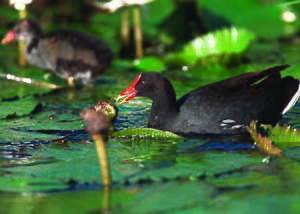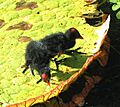Hawaiian gallinule facts for kids
Quick facts for kids Hawaiian gallinule |
|
|---|---|
 |
|
| Conservation status | |
| Scientific classification |
|
| Kingdom: | Animalia |
| Phylum: | Chordata |
| Class: | Aves |
| Order: | Gruiformes |
| Family: | Rallidae |
| Genus: | Gallinula |
| Species: | |
| Subspecies: |
G. g. sandvicensis
|
| Trinomial name | |
| Gallinula galeata sandvicensis Streets, 1877
|
|
| Synonyms | |
|
|
The Hawaiian gallinule (Gallinula galeata sandvicensis) is an endangered water bird about the size of a chicken. It belongs to the rail family. People also call it the Hawaiian common gallinule, Hawaiian moorhen, or `alae `ula in Hawaiian. This name means “burnt forehead” because of the bright red shield on its face.
This bird is a special type, or subspecies, of the common gallinule. It lives only in the Hawaiian Islands in the Pacific Ocean. The Hawaiian gallinule needs freshwater wetlands with lots of plants for nesting. It used to live on most of the main Hawaiian islands. But its numbers have dropped a lot. Now, you can only find it living on Kaua'i and O'ahu. The main reasons for its decline were losing its home, hunting, and attacks from animals brought to the islands. Today, laws protect the bird, and people are working to help it. Even though people once hunted it for food, it was also important in Hawaiian religion. They believed it was the keeper of fire.
Contents
About the Hawaiian Gallinule
It is thought that the Hawaiian gallinule came from common gallinules that flew over from North America. This bird used to be considered a subspecies of the common moorhen. Later, in 2011, it became a subspecies of the common gallinule. You can tell it apart from other gallinules by its larger red shield on its face. It also has a reddish color on the front and sides of its lower legs.
What It Looks Like
The Hawaiian gallinule has dark grey-brown feathers on its back. Its head and neck are black, and its belly is a dark slate-blue color. It has white feathers under its tail and white stripes on its sides. A large red shield covers its forehead, and its bill is red with a yellow tip. Its strong legs and long-toed feet are mostly yellowish-green. Male and female gallinules look similar. An adult gallinule is about 33 centimeters (13 inches) long. They usually weigh around 350 grams (12 ounces). Young birds are olive to greyish-brown with duller, pale yellow to brown bills.
How to Identify It
It's easy to tell the Hawaiian gallinule apart from the only similar bird in its area, the Hawaiian coot. The coot has a white shield on its face, not red. The gallinule's calls sound like "chicken-like cackling and croaks." These sounds are louder and higher-pitched than the coot’s calls.
Behavior and Life Cycle
Hawaiian gallinules are shy birds. They spend most of their time hidden in thick wetland plants. If they are feeding in the open and something disturbs them, they quickly hide. However, in some places, they are quite friendly and will even come close to people. Even though their toes are not webbed, these birds are good swimmers. They shed their feathers once a year, usually between June and September. During this time, they cannot fly, which makes them more vulnerable to predators.
Reproduction
Hawaiian gallinules can breed all year, but they breed most often from March to August. Breeding depends on how much water and plants are available. Breeding pairs protect their nesting areas. They build their nests hidden in thick plants above shallow, still fresh water. The water is usually less than 60 centimeters (2 feet) deep. Nests are built on platforms of flattened plants close to the water's surface. Flooding is a big reason why nests fail.
A nest is about 26 centimeters (10 inches) across. The inside is about 16 centimeters (6 inches) wide and 5 centimeters (2 inches) deep. A female usually lays five or six eggs. The eggs hatch after 19 to 22 days. When the chicks hatch, the adult birds eat or remove the eggshells from the nest. The chicks are precocial, meaning they can walk and swim soon after hatching. But they rely on their parents for protection and food for about 21 to 25 days. After that, they start finding their own food.
Feeding Habits
These birds look for food in and near thick wetland plants. They eat many different things, depending on what they can find. Their diet includes plant material like algae, grass, and seeds. They also eat small animals without backbones, such as snails and aquatic insects.
Where They Live and Their Home
The gallinule used to live on all the main Hawaiian Islands except Lanai and Kahoolawe. Now, it only lives on Kaua`i and O`ahu. Each island has about half of the remaining birds. On Kaua‘i, where there are no mongooses, the birds live in lowland wetlands and valleys. This includes the Hanalei and Wailua River valleys. They also live in irrigation channels on the Mānā Plains. The Hanalei National Wildlife Refuge is a very important place for them.
On O‘ahu, the birds are found all over the island. They are mostly on the northern and eastern coasts. Smaller numbers live at Pearl Harbor and the Lualualei Valley.
The gallinule mainly lives in freshwater wetlands that are usually below 125 meters (410 feet) in height. These places include streams, springs, natural ponds, marshes, and wet meadows. They also live in lotus and taro fields, reservoirs, and drainage ditches. They prefer thick plants near open water, often with floating mats of plants. The water should be less than a meter (3 feet) deep. Sometimes, they visit salty or ocean wetlands like lagoons and shrimp farms. Even though these birds do not migrate, studies show that some birds move between wetlands (and possibly between islands) in the spring. This happens when water levels change.
Status and Protecting Them
The number of Hawaiian gallinules and the areas where they lived decreased during the 1800s and early 1900s. By the late 1940s, people thought the bird was in danger. On Hawai`i Island, the last gallinules were seen in 1887. Attempts to bring them back in the 1920s and 1950s failed. They disappeared from Moloka`i after the 1940s. An attempt to bring them back in 1983 also failed, as five of the six birds were shot for food. In 1967, the gallinule was listed as endangered under the US Federal Endangered Species Act. The State of Hawai'i also lists it as endangered.
Surveys in the 1950s and 1960s found fewer than 57 birds. But numbers have increased since then. Recent counts show that the population is low but stable. It's hard to count these shy birds. From 1998 to 2007, the average number counted each year was 287 birds. However, experts believe the total population is around 750 birds.
The main reasons for the decline include farming, building homes, and creating recreation areas. These activities caused wetlands to be lost or changed. Animals brought to the islands, like bullfrogs, rats, cats, dogs, and mongooses, hunt the gallinules, especially at their nests. Hunting was also a big problem until it was banned in 1939. Today, threats include illegal hunting and people destroying nests.
To help the gallinules, people are working to protect and manage wetlands. They also control predators, enforce hunting laws, and teach the public about the birds. They also work with private groups and landowners.
Mythology and Culture
According to Hawaiian historian David Malo, the gallinule was seen as a god and worshipped. One legend says the bird was the keeper of fire for the gods. The culture hero Maui then learned the secret of fire-making from it. Another version says the bird felt sorry for humans and stole fire from the gods so people could stay warm and cook. Both stories say the bird's red frontal shield comes from being scorched by fire. Hawaiians also believed that hearing the bird's cry at night was bad luck, predicting death. Gallinules were eaten, caught by chasing them down or throwing stones. Their meat was said to be tasty, though a bit gamey and tough.
Images for kids








